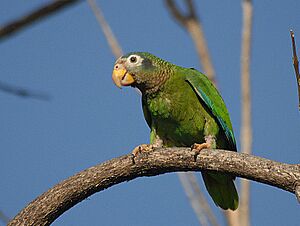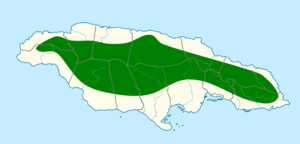Yellow-billed amazon facts for kids
Quick facts for kids Yellow-billed amazon |
|
|---|---|
 |
|
| At St. Andrew, Jamaica | |
| Conservation status | |
| Scientific classification | |
| Genus: |
Amazona
|
| Species: |
collaria
|
 |
|
| Synonyms | |
|
|
The yellow-billed amazon (Amazona collaria) is a special type of parrot. People also call it the yellow-billed parrot or Jamaican amazon. This beautiful bird is mostly green with a short tail. It has a pink throat and neck.
This parrot lives only in Jamaica. Its natural homes are warm, wet forests, including mangrove forests and mountain forests. You can also find it in plantations and gardens. Sadly, the yellow-billed amazon is in danger. Its home is shrinking, and some people illegally catch these wild birds to sell as pets.
The famous scientist Carl Linnaeus first described the yellow-billed amazon in 1758. He wrote about it in his important book, Systema Naturae.
What is the Yellow-billed Amazon?
The yellow-billed amazon is about 28 centimeters (11 inches) long. Its feathers are mostly green. It has pink feathers on its throat, upper chest, and sides of its neck. The larger feathers on its wings are blue.
The feathers around its ears are dark blue-green. It has white rings around its eyes. A thin white band goes across its forehead. The feathers near its beak are light blue, and its fore-crown is blue. The green feathers on its back and neck have black tips. This makes them look striped.
The tail feathers are green with red at the bottom. This parrot has a yellow beak and brown eyes. Its legs are pink. Male and female yellow-billed amazons look the same. Young parrots have a grey upper beak but look much like the adults.
Where Does This Parrot Live?
The yellow-billed amazon lives on the island of Jamaica. It can be found up to 1,200 meters (about 3,900 feet) high. It is more common in places like the John Crow Mountains, Mount Diablo, and the Cockpit Country. During the time when they have babies, they stay in rainforests.
Why is the Yellow-billed Amazon in Danger?
The yellow-billed amazon is listed as a vulnerable species. This means it is at risk of becoming endangered. The International Union for Conservation of Nature (IUCN) keeps track of this. These parrots are protected by an agreement called CITES. This agreement makes it illegal to trade or export wild birds that have been caught.
The groups of these parrots are spread out, and they live in a small area. They are in danger because:
- Their homes are disappearing.
- People illegally catch them to sell as pets.
- Trees with good nesting spots are being cut down.
They are also threatened by other pet amazon parrots that escape. These escaped parrots might mix with the wild yellow-billed amazons. This happens more often during hurricane season.


